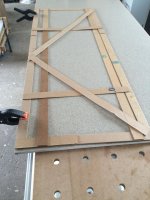Kodi Crescent
Member
- Joined
- Aug 6, 2010
- Messages
- 791
Hi,
I need some advice on taping a drywall corner I'm finishing.
I'm working on installing cabinets in what will be an office area. The cabinets will occupy an entire back wall of this room, and the counters need to fit into corners. I've taped the drywall and am in the process of finishing it.
In one of the corners the walls are out of square. I've been floating the drywall in the offending corner with setting compound in an effort to build it up. Unfortunately, the corner was about 1/2" out of square. So my buildup layers are something to the effect of drywall, paper tape, drying-type compound (green lid stuff), several thicker coats of setting compound, and soon to be a few thin coats of drying compound to make it square.
Since I have a thick buildup area, should I re-tape it before my final few coats of drying compound? I'm not sure what to expect in regards to cracking, and if a second coat of tape would prevent that. Thanks for your advice!
On a similar note, is there a method for scribing a countertop into an out of square corner?
I need some advice on taping a drywall corner I'm finishing.
I'm working on installing cabinets in what will be an office area. The cabinets will occupy an entire back wall of this room, and the counters need to fit into corners. I've taped the drywall and am in the process of finishing it.
In one of the corners the walls are out of square. I've been floating the drywall in the offending corner with setting compound in an effort to build it up. Unfortunately, the corner was about 1/2" out of square. So my buildup layers are something to the effect of drywall, paper tape, drying-type compound (green lid stuff), several thicker coats of setting compound, and soon to be a few thin coats of drying compound to make it square.
Since I have a thick buildup area, should I re-tape it before my final few coats of drying compound? I'm not sure what to expect in regards to cracking, and if a second coat of tape would prevent that. Thanks for your advice!
On a similar note, is there a method for scribing a countertop into an out of square corner?


